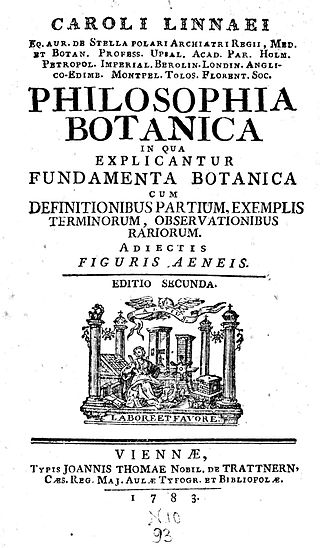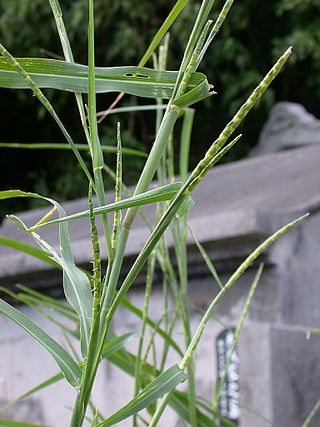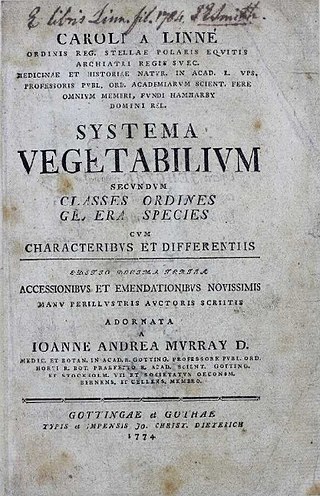
Carl Linnaeus, also known after ennoblement in 1761 as Carl von Linné, was a Swedish biologist and physician who formalised binomial nomenclature, the modern system of naming organisms. He is known as the "father of modern taxonomy". Many of his writings were in Latin; his name is rendered in Latin as Carolus Linnæus and, after his 1761 ennoblement, as Carolus a Linné.

William Withering FRS was an English botanist, geologist, chemist, physician and first systematic investigator of the bioactivity of digitalis.

Johann Friedrich Gmelin was a German naturalist, chemist, botanist, entomologist, herpetologist, and malacologist.

Systema Naturae is one of the major works of the Swedish botanist, zoologist and physician Carl Linnaeus (1707–1778) and introduced the Linnaean taxonomy. Although the system, now known as binomial nomenclature, was partially developed by the Bauhin brothers, Gaspard and Johann, Linnaeus was first to use it consistently throughout his book. The first edition was published in 1735. The full title of the 10th edition (1758), which was the most important one, was Systema naturæ per regna tria naturæ, secundum classes, ordines, genera, species, cum characteribus, differentiis, synonymis, locis, which appeared in English in 1806 with the title: "A General System of Nature, Through the Three Grand Kingdoms of Animals, Vegetables, and Minerals, Systematically Divided Into their Several Classes, Orders, Genera, Species, and Varieties, with their Habitations, Manners, Economy, Structure and Pecularities".
Jakob Friedrich Ehrhart was a German botanist, a pupil of Carl Linnaeus at Uppsala University, and later director of the Botanical Garden of Hannover, where he produced several major botanical works between 1780 and 1793. Ehrhart was the first author to use the rank of subspecies in botanical literature, and he published many subspecific names between 1780 and 1789.

Carl Linnaeus the Younger, Carolus Linnaeus the Younger, Carl von Linné den yngre, or Linnaeus filius was a Swedish naturalist. His names distinguish him from his father, the pioneering taxonomist Carl Linnaeus (1707–1778).

As with other flowering plants, the taxonomy of Banksia has traditionally been based on anatomical and morphological properties of the Banksia flower, fruiting structure and seed, along with secondary characteristics such as leaf structure and growth habit. Increasingly, molecular evidence from DNA is providing important new insights into relationships within the genus and between this and other genera in the Proteaceae.

Olof Peter Swartz was a Swedish botanist and taxonomist. He is best known for his taxonomic work and studies into pteridophytes.

De Fructibus et Seminibus Plantarum, also known by its standard botanical abbreviation Fruct. Sem. Pl., is a three-volume botanic treatise by Joseph Gaertner. The first volume was published in December 1788. The second volume was published in four parts, in 1790, 1791, 1791, and 1792 respectively. A third volume was published after Gaertner's death by his son Karl Friedrich von Gaertner from 1805 to 1807; this final volume is also known as 'Supplementum Carpologicae', abbreviated as Suppl. Carp.. Most of the illustrations for the work were done by Johann Georg Sturm (1742-1793).

Philosophia Botanica was published by the Swedish naturalist and physician Carl Linnaeus (1707–1778) who greatly influenced the development of botanical taxonomy and systematics in the 18th and 19th centuries. It is "the first textbook of descriptive systematic botany and botanical Latin". It also contains Linnaeus's first published description of his binomial nomenclature.

Rottboellia is a genus of African, Asian, and Australian plants in the grass family.
Hoplophyllum is a genus of flowering plants in the family Asteraceae. It has two species, Hoplophyllum spinosum and Hoplophyllum ferox, both native to South Africa.

The bibliography of Carl Linnaeus includes academic works about botany, zoology, nomenclature and taxonomy written by the Swedish botanist Carl Linnaeus (1707–1778). Linnaeus laid the foundations for the modern scheme of binomial nomenclature and is known as the father of modern taxonomy. His most famous works are Systema Naturae which is considered as the starting point for zoological nomenclature together with Species Plantarum which is internationally accepted as the beginning of modern botanical nomenclature.

Critica Botanica was written by Swedish botanist, physician, zoologist and naturalist Carl Linnaeus (1707–1778). The book was published in Germany when Linnaeus was 29 with a discursus by the botanist Johannes Browallius (1707–1755), bishop of Åbo. The first edition was published in July 1737 under the full title Critica botanica in qua nomina plantarum generica, specifica & variantia examini subjiciuntur, selectoria confirmantur, indigna rejiciuntur; simulque doctrina circa denominationem plantarum traditur. Seu Fundamentorum botanicorum pars IV Accedit Johannis Browallii De necessitate historiae naturalis discursus.

Strelitzia alba also known as white-flowered wild banana, or Cape wild banana is a plant of the Bird of Paradise family and is endemic to the Garden Route along the southernmost coastal regions of the district of Humansdorp Eastern and district of Knysna in Western Cape in South Africa. It grows in evergreen forest, gorges, and on slopes along the rivers.

Johan Andreas (Anders) Murray was a Swedish physician of German descent and botanist, who published a major work on plant-derived medicines.
Mantissa Plantarum Altera is an illustrated book with botanical descriptions which was edited by the Swedish naturalist Carl Linnaeus in the year 1771.

Systema Vegetabilium is a book published in four editions, following twelve earlier editions known as Systema Naturae. The first edition, published in 1774 and edited by Johan Andreas Murray is counted as edition 13 because it continues from the 12th edition of Systema Naturae. All the names in it are attributed to Carl Linnaeus. The second edition, published in 1784, includes plant species described by J.A. Murray and Carl Peter Thunberg. The third edition, was edited by Christiaan Hendrik Persoon
Élisabeth Julienne Pommereul was a French botanist who worked under the teachings of the French botanist Tournefort and Swedish botanist Linnaeus to study classifications and counts of grass types in the Jardin du Roi.

Tribolium uniolae is a grass in the subfamily Danthonioideae of the Poaceae, native to Cape Province, South Africa. It was first described in by Carl Linnaeus, the younger, as Cynosurus uniolae, but in 1985 was transferred to the genus, Tribolium, by Stephen Andrew Renvoize.
















